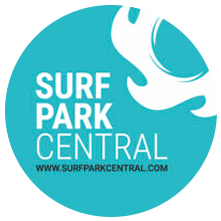As the surf park industry accelerates and occupies ever more real estate in the collective surfers’ imagination, we find ourselves having to create new language to describe entirely new things. Surf park guests struggle for the right language to compare rides or compliment fellow surfers. “Wow, that was a nice one” loses some of its meaning when “that one” was much the same as the one before and after it and all the other waves on that setting for the life of the wave generating system.

The WSL borrowed from other board and action sports to describe surfers having ‘runs’ consisting of a left and a right that riders were guaranteed at the Surf Ranch contests. Surf park operations pioneer Cheyne Magnusson has explained at Surf Park Summits past how he talks to guests in terms of “opportunities” rather than “waves” to account for waves blown on take off or missed completely (hey, it happens to the best of us, rumor has it that there is video evidence of Surf Park Central founder John Luff missing the first buttery wave of the day at Waco Surf). So, for example, guests are told they have 10 opportunities rather than 10 waves to avoid disappointment and confusion.
Various nouns have been used to describe these new inland surfing attractions, and they tend to be used interchangeably. This has led to a good deal of confusion around precisely what is being referred to: wave pool, wave basin, surf lagoon, surf pool, surf park argh! Do they all describe the same thing or are there differences? Distinctions come with consequences when surf park neologisms are used to codify rules, regulations, and safety codes that will dictate what is possible in the industry and how it can be done. The language we use, how it affects peoples’ perceptions, and how it is integrated into laws and codes will have and is already having non-trivial downstream effects on CapEx and OpEx, as well as user experience and customer throughput.
Terms in the Surf Park Industry
So, let’s look at some of the terms being used and try to establish some clarity around definitions so we can all speak the same language. Before we start forming neologistic compound words of the open and closed varieties, let’s start with the basics.

Wave
In the realms of oceanography and fluid dynamics, a wave is considered to be the transport of a disturbance (essentially energy) in space, while the medium in which the disturbance is traveling is not in motion. In the ocean, waves of energy travel across/through the ocean. The water particles that transport energy simply move in circles, giving the illusion of water moving, but in reality, it is energy moving through the water that is moving but only in relatively small circles (trippy right?!). Surf historian Matt Warshaw describes surfing as the process of riding “ocean transported sunbeams” because ocean waves are created when energy from the sun causes changes in atmospheric pressure, resulting in wind. Wind transmits the sun’s energy into the ocean, creating ripples on its surface. If the wind blows strong and straight enough over a large enough distance (this is called ‘fetch’), it creates swell, groups of waves that can propagate across entire oceans and well beyond the wind event that created them. But at this point, we still don’t have surf.
Surf
Surf is what happens when a wave breaks. In natural settings, a wave breaks when the bottom of the wave slows down. You can think of it a bit like a person tripping over as their lower body stops and the top part of their body continues forward. Waves slow down when they touch the bottom of the ocean, and this happens when the depth of the ocean is half the wavelength (the distance between two identical points on successive waves – crest to crest or trough to trough). The slowing at the bottom of the wave causes the wave height to increase as the amplitude increases (there is still the same amount of energy involved, waves behind are moving at the original speed and the energy has to go somewhere, in this case, it goes up). When the wave height exceeds 1/7th of the wavelength, it becomes unstable, trips over its feet, and breaks. Now we have surf.
Surfers have muddied the water when it comes to the terms ‘wave’ and ‘surf’, using them interchangeably to describe the ocean-transported sunbeams that we ride. It is probably more accurate to say that we ride the small areas where waves transition into surf. The recent advent of foiling has allowed surfers to ride waves in the absence of surf, but surfers generally ride the energy of a wave while it is in the process of breaking. This distinction between waves as energy moving through water without actually moving the water (other than oscillating in circles), and surf as what happens when waves peak up, trip over, and break where water is actually moving is a starting point for standardizing nomenclature for human-made surfing attractions. Now, we have the tools to pull apart the compound neologisms and attempt to develop some precision in their use. Below are definitions of some key terms in the space. These are not intended to be critiques of different systems but rather a point of definition to aid conversation and debate.
Wavepool/Wave Pool
A wave pool is simply a pool with waves in it. Like the very first wave pools of mad King Ludwig and the Undosa Wellenbad in the late 19th and early 20th century, respectively, a wave pool is not designed for surfing. Many hundreds were constructed over the course of the 20th century. The waves in a wave pool are generally not designed to break, or to create small gentle spilling waves. Wave pools are designed for aesthetic amenity and/or to provide a slightly more exciting and ‘enhanced swimming experience’. Wave pools remain popular today in recreation and leisure centers all over the world, and they are particularly popular in China where, in some cases, as many as 6000 people in flotation rings cram, sardine like, together and bob over gentle waves pulsing through the wave pool. It makes for mesmerizing viewing, but it ain’t surfing.
Aerial shooting : Wave Pool (China)
Surf Lagoon/Surf Basin/Wave Basin
Compared to a wavepool, this is a body of water in which waves are generated and designed to break in a way that facilitates high quality surfing experiences. While the term ‘surf pool’ is used extensively in the media, I believe it is a term that we should be trying to avoid in favor of ‘surf basin’ or ‘surf lagoon.’ Why? When it comes to introducing the surf park concept to new audiences, particularly regulators and legislators, it is important that swimming pools are not conflated with surfing lagoons/basins. Swimming pools are generally much smaller than a surfing lagoon and are designed and regulated with much higher densities of users in mind. Regulatory issues around filtration, residual chlorine, safety protocols and lifeguarding just to name a few are all influenced by how regulators consider a surf lagoon as compared with a pool, something they are far more familiar with. It is important that this distinction between pool and lagoon/basin enters the surf park lexicon.
Surf Park
A surf park is a recreation facility or attraction that contains a surf lagoon or a standing wave attraction (see below). The term refers to and encompasses elements beyond the surf lagoon/standing wave. A surf park might include several wave generating technologies, FnB, accommodation, retail, gymnasium, spa, commercial and residential real estate, and other attractions such as skate parks/pump tracks, climbing walls, water obstacle courses, zip lines etc.

Standing or Stationary Waves
There are two different types of standing or stationary waves – sheet waves and deepwater standing waves.
Sheet Wave
A wave simulation technology that shoots a thin sheet of water at high velocity over a carefully designed surface. Depending on the speed of the water and the shape of the surface it travels over, different types of sheet waves can be created. Sheet waves are so shallow that normal surfboards cannot be ridden. Boards more similar to a skateboard deck or a skimboard are generally used. Flowrider and Flowbarrel, invented by Tom Lochtefeld, were the first to market in the 1990s. Pacific Surf Designs are also a sheet wave attraction technology provider.
Flowbarrel, invented by Tom Lochtefeld, now owned by Whitewater West
Pacific Surf Designs’ Supertube Model
Deep Water Standing Wave/Hydraulic Jump
Leonardo DaVinci was the first person to describe the hydraulic jump phenomena in the 1500s before early Italian hydraulics and fluid dynamics pioneer Gorgio Bidone described the mathematics involved in 1820. This is the type of wave found in rivers, such as the Eisbach or Ice River in Munich, Germany which has inspired many standing wave inventors and which supports a thriving inland urban surfing community. Famously, when the lagoon at Waimea Bay on Oahu is opened up to the ocean a high quality hydraulic jump is formed that is regularly ridden by surfing’s biggest stars.
Munich’s Eisbach Pneumatic Jump Waimea Lagoon
An important distinction here is that a deepwater standing wave can be ridden on a normal surfboard rather than a specially designed surfboard with smaller fins or no fins at all. Technologies producing deep water standing waves include City Wave, ADG’s Epic Surf, UNIT Surf, Your Wave, and Whitewater’s Flow Surf.
Pneumatic Systems
Pneumatic wave generating systems use compressed air applied to water to create waves. Technologies including American Wave Machines’ Perfect Swell, Endless Surf and Surfloch all use similar pneumatic technology. Water is initially pulled into chambers or caissons, which are fired in specific sequences using compressed air to force water out and across the wave basin.
Electro-Mechanical Systems
Electro-mechanical wave generating systems apply force to water in a surf lagoon via electrically powered machinery. There are several technologies using this type of system. Wavegarden Cove uses a modular central pier with moving paddles while Swell MFG uses a modular system arranged on the back wall of the lagoon to push down on the water to generate waves.
Foil Systems
Foil systems pull or push a foil through the water, essentially creating a bow wave that is the primary surfing wave. Several foil systems were attempted and abandoned, including Surfloch’s flying reef and Wavegarden’s Lagoon. The Kelly Slater Wave Company technology is currently the only foil system in operation.
Pneumatic/Hydraulic Systems
Surf Lakes is currently the only technology using a pneumatic/hydraulic system. Compressed air raises a heavy weight with deep water under it in the center of a relatively shallow lagoon. The air pressure is then released, dropping the weight into the lagoon, creating concentric circular waves.
Final Thoughts
Words matter. Especially when it comes to establishing new standards, guidelines, regulations, and rules around surf park technologies and operations. The underlying idea here is to help ensure that the language we, as an industry and user/enthusiast base, use is words that are best suited to avoiding regulatory confusion as the industry becomes increasingly well defined and codified. What are your thoughts on the matter? If you have suggestions or comments, please let me know.
























You must be logged in to post a comment Login